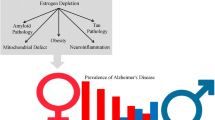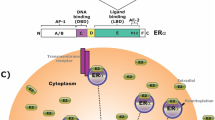Abstract
Glutamate is the most abundant excitatory brain neurotransmitter that has important functional significance with respect to neurodegenerative conditions. Glutamate-mediated excitotoxicity and neurodegeneration in Alzheimer’s disease (AD) has been gradually becoming elucidated recently. Excessive release of glutamate induces an increase in intracellular Ca2+ levels, thus triggers a cascade of cellular responses, ultimately leading to neuronal cell death. This type of neuronal damage induced by over-excitation has been proposed to be involved in a number of neuropathological conditions, ranging from acute insults to chronic neurodegenerative disorders. Estrogen could be effective in modulating glutamate-induced neurotoxicity and the protective responsivenesses are mostly estrogen receptors (ERs)-dependent. However, the mechanism underlying estrogen’s neuroprotective effect is not fully clarified and is complicated by the presence of several distinct ER types. So a deeper research into the neuroprotection of ERs might be informative about the positive effect that estrogen might have on ageing-related cognitive changes. Extensive studies have indicated the neuroprotective effects of ERs against glutamate-induced neurotoxicity. The purpose of this review is to elucidate ERs’ neuroprotective effects against glutamate-induced cytotoxicity and explore new ways to prevent and cure neurotoxicity-associated neurodegenerative disorders.

Similar content being viewed by others
References
Gazulla J, Cavero-Nagore M (2006) Glutamate and Alzheimer’s disease. Rev Neurol 42:427–432
Crescenzi R, DeBrosse C, Nanga RP et al (2014) In vivo measurement of glutamate loss is associated with synapse loss in a mouse model of tauopathy. Neuroimage. [pii]: S1053-8119(14)00544-8
Burbaeva GS, Boksha IS, Tereshkina EB et al (2014) A role of glutamate decarboxylase in Alzheimer’s disease. Zh Nevrol Psikhiatr Im S S Korsakova 114(4):68–72
Ribeiro FM, Devries RA, Hamilton A et al (2014) Metabotropic glutamate receptor 5 knockout promotes motor and biochemical alterations in a mouse model of Huntington’s disease. Hum Mol Genet 23(8):2030–2042
Rettberg JR, Yao J, Brinton RD (2014) Estrogen: a master regulator of bioenergetic systems in the brain and body. Front Neuroendocrinol 35(1):8–30
Zhao L, Brinton RD (2007) Estrogen receptor alpha and beta differentially regulate intracellular Ca2+ dynamics leading to ERK phosphorylation and estrogen neuroprotection in hippocampal neurons. Brain Res 1172:48–59
Kajta M, Domin H, Grynkiewicz G et al (2007) Genistein inhibits glutamate-induced apoptotic processes in primary neuronal cell cultures: an involvement of aryl hydrocarbon receptor and estrogen receptor/glycogen synthase kinase-3beta intracellular signaling pathway. Neuroscience 145(2):592–604
Gingerich S, Kim GL, Chalmers JA et al (2010) Estrogen receptor alpha and G-protein coupled receptor 30 mediate the neuroprotective effects of 17beta-estradiol in novel murine hippocampal cell models. Neuroscience 170(1):54–66
Kuo JR, Wang CC, Huang SK et al (2012) Tamoxifen depresses glutamate release through inhibition of voltage-dependent Ca2+ entry and protein kinase Cot in rat cerebral cortex nerve terminals. Neurochem Int 60(2):105–114
Millan C, Torres M, Sanchez-Prieto J (2003) Co-activation of PKA and PKC in cerebrocortical nerve terminals synergistically facilitates glutamate release. J Neurochem 87(5):1101–1111
Wang SJ, Sihra TS (2004) Noncompetitive metabotropic glutamate 5 receptor antagonist (E)-2-methyl-6-styryl-pyridine (SIB1893) depresses glutamate release through inhibition of voltage-dependent Ca2+ entry in rat cerebrocortical nerve terminals (synaptosomes). J Pharmacol Exp Ther 309(3):951–958
Pittaluga A, Feligioni M, Longordo F et al (2005) Somatostatin induced activation and up-regulation of N-methyl-D-aspartate receptor function: mediation through calmodulin-dependent protein kinase II, phospholipase C, proteinkinase C, and tyrosine kinase in hippocampal noradrenergic nerve endings. J Pharmacol Exp Ther 313(1):242–249
Yang TT, Wang SJ (2008) Facilitatory effect of glutamate exocytosis from rat cerebrocortical nerve terminals by alpha-tocopherol, a major vitamin E component. Neurochem Int 52(6):979–989
Lu CW, Lin TY, Wang SJ (2010) Memantine depresses glutamate release through inhibition of voltage-dependent Ca2+ entry and protein kinase C in rat cerebral cortex nerve terminals: an NMDA receptor-independent mechanism. Neurochem Int 57(2):168–176
Gursoy E, Cardounel A, Al-khlaiwi T et al (2002) Tamoxifen protects clonal mouse hippocampal (HT-22) cells against neurotoxins-induced cell death. Neurochem Int 40(5):405–412
Lee ES, Yin Z, Milatovic D et al (2009) Estrogen and tamoxifen protect against Mn-induced toxicity in rat cortical primary cultures of neurons and astrocytes. Toxicol Sci 110(1):156–167
McMullan SM, Phanavanh B, Li GG et al (2012) Metabotropic glutamate receptors inhibit microglial glutamate release. ASN Neuro 4(5) (e00094)
Graeber MB, Li W, Rodriguez ML (2011) Role of microglia in CNS inflammation. FEBS Lett 585:3798–3805
Kelley KW, Dantzer R (2011) Alcoholism and inflammation: neuroimmunology of behavioral and mood disorders. Brain Behav Immun Suppl 1:S13–S20
Andrew M, Fukuda Jerome Badaut (2012) Aquaporin 4: a player in cerebral edema and neuroinflammation. J Neuroinflammation 9:279
Lee E, Sidoryk-Wegrzynowicz M, Wang N et al (2012) GPR30 regulates glutamate transporter GLT-1 expression in rat primary astrocytes. J Bio Chem 287(32):26817–26828
Lee E, Sidoryk-Wegrzynowicz M, Yin Z et al (2012) Transforming growth factor-alpha mediates estrogen-induced upregulation of glutamate transporter GLT-1 in rat primary astrocytes. Glia 60(7):1024–1036
Kiss J, Csaba Z, Csaki A et al (2013) Demonstration of estrogen receptor alpha protein in glutamatergic (vesicular glutamate transporter 2 immunoreactive) neurons of the female rat hypothalamus and amygdala using double-label immunocytochemistry. Exp Brain Res 226(4):595–602
Cimarosti H, O’Shea RD, Jones NM et al (2006) The effects of estradiol on estrogen receptor and glutamate transporter expression in organotypic hippocampal cultures exposed to oxygen-glucose deprivation. Neurochem Res 31(4):483–490
Hamby ME, Sofroniew MV (2010) Reactive astrocytes as therapeutic targets for CNS disorders. Neurotherapeutics 7(4):494–506
Lee ES, Sidoryk M, Jiang H (2009) Estrogen and tamoxifen reverse manganese-induced glutamate transporter impairment in astrocytes. J Neurochem 110(2):530–544
Pawlak J, Brito V, Kuppers E et al (2005) Regulation of glutamate transporter GLAST and GLT-1 expression in astrocytes by estrogen. Brain Res Mol Brain Res 138(1):1–7
Kim K, Lee SG, Kegelman TP et al (2011) Role of excitatory amino acid transporter-2 (EAAT2) and glutamate in neurodegeneration: opportunities for developing novel therapeutics. J Cell Physiol 226(10):2484–2493
Lipatova O, Byrd D, Green JT et al (2014) Effects of continuous vs. cycling estrogen replacement on the acquisition, retention and expression of place- and response-learning in the open-field tower maze. Neurobiol Learn Mem 114C:81–89
Szego EM, Barabas K, Balog J et al (2006) Estrogen induces estrogen receptor alpha-dependent cAMP response element-binding protein phosphorylation via mitogen activated protein kinase pathway in basal forebrain cholinergic neurons in vivo. J Neurosci 26(15):4104–4110
Mermelstein PG (2009) Membrane-localised oestrogen receptor alpha and beta influence neuronal activity through activation of metabotropic glutamate receptors. J Neuroendocrinol 21(4):257–262
Grove-Strawser D, Boulware MI, Mermelstein PG (2010) Membrane estrogen receptors activate the metabotropic glutamate receptors mGluR5 and mGluR3 to bidirectionally regulate CREB phosphorylation in female rat striatal neurons. Neuroscience 170(4):1045–1055
Boulware MI, Weick JP, Becklund BR et al (2005) Estradiol activates group I and II metabotropic glutamate receptor signaling, leading to opposing influences on cAMP response element-binding protein. J Neurosci 25(20):5066–5078
Boulware MI, Mermelstein PG (2009) Membrane estrogen receptors activate metabotropic glutamate receptors to influence nervous system physiology. Steroids 74(7):608–613
Spampinato SF, Molinaro G, Merlo S et al (2012) Estrogen receptors and type 1 metabotropic glutamate receptors are interdependent in protecting cortical neurons against beta-amyloid toxicity. Mol Pharmacol 81(1):12–20
Kuo J, Hariri OR, Bondar G et al (2009) Membrane estrogen receptor-alpha interacts with metabotropic glutamate receptor type 1a to mobilize intracellular calcium in hypothalamic astrocytes. Endocrinology 150(3):1369–1376
Chaban V, Li J, McDonald JS et al (2011) Estradiol attenuates the adenosine triphosphate-induced increase of intracellular calcium through group II metabotropic glutamate receptors in rat dorsal root ganglion neurons. J Neurosci Res 89(11):1707–1710
Al-Sweidi S, Morissette M, Di Paolo T (2012) Effect of oestrogen receptors on brain NMDA receptors of 1-methyl-4-phenyl-1,2,3,6-tetrahydropyridine mice. J Neuroendocrinol 24(11):1375–1385
Traynelis SF, Wollmuth LP, McBain CJ et al (2010) Glutamate receptor ion channels: structure, regulation, and function. Pharmacol Rev 62(3):405–496
Bryant DN, Dorsa DM (2010) Roles of estrogen receptors alpha and beta in sexually dimorphic neuroprotection against glutamate toxicity. Neuroscience 170(4):1261–1269
Aguirre C, Jayaraman A, Pike C et al (2010) Progesterone inhibits estrogen-mediated neuroprotection against excitotoxicity by down-regulating estrogen receptor-beta. J Neurochem 115(5):1277–1287
Carswell HV, Macrae IM, Gallagher L et al (2004) Neuroprotection by a selective estrogen receptor beta agonist in a mouse model of global ischemia. Am J Physiol Heart Circ Physiol 287(4):H1501–H1504
Zhao L, Wu TW (1010) Brinton RD (2004) Estrogen receptor subtypes alpha and beta contribute to neuroprotection and increased Bcl-2 expression in primary hippocampal neurons. Brain Res 1–2:22–34
Gingerich S, Kim GL, Chalmers JA et al (2010) Estrogen receptor alpha and G-protein coupled receptor 30 mediate the neuroprotective effects of 17beta-estradiol in novel murine hippocampal cell models. Neuroscience 170(1):54–66
Liu N, Shang J, Tian F et al (2011) In vivo optical imaging for evaluating the efficacy of edaravone after transient cerebral ischemia in mice. Brain Res 1397:66–75
Acknowledgments
The work was supported by the National Natural Science Foundation of China (81371223 and 81371437) and the Research Fund for the Doctoral Program of Higher Education of China (20122105110010).
Conflict of interest
The authors declare that they have no conflict of interest related to the publication of this article.
Author information
Authors and Affiliations
Corresponding authors
Rights and permissions
About this article
Cite this article
Lan, YL., Zhao, J. & Li, S. Estrogen receptors’ neuroprotective effect against glutamate-induced neurotoxicity. Neurol Sci 35, 1657–1662 (2014). https://doi.org/10.1007/s10072-014-1937-8
Received:
Accepted:
Published:
Issue Date:
DOI: https://doi.org/10.1007/s10072-014-1937-8




